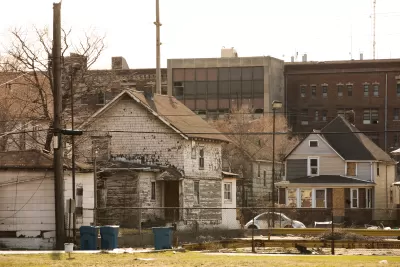As more evidence shows that neighborhood-level factors heavily impact future outcomes, place-based policies should use more accurate measurements to ensure persistently poor places don’t fall through the cracks.

A commentary in Route Fifty by August Benzow and Kenan Fikri describes how new research explains “how an economically distressed place can transmit poverty from one generation to the next.”
For the authors; it is important to point out that “Pioneering researchers like Harvard’s Raj Chetty have shown that children who grow up in high-poverty environments are less likely to climb the income ladder as adults,” contrary to the popular American narrative of bootstrap success.
For Benzow and Fikri, “the way we measure and target persistent poverty leaves millions of vulnerable Americans invisible to programs intended to support them.” This includes how places are designated as ‘chronically poor,’ which is currently done at the county level. “Looking no deeper severely underestimates the size of the problem and therefore the scope of the challenge. Roughly 20.5 million Americans live in a persistent-poverty county, but 35 million reside in a persistent-poverty census tract.”
The article concludes that “high poverty rates will persist across thousands of American communities because the fabric that weaves them into the national economy has grown threadbare.” The authors call for “a growth agenda for persistent-poverty communities—the very places where the nation’s social and economic challenges are greatest.”
FULL STORY: Will the new wave of place-based policy leave persistently poor areas behind?

Alabama: Trump Terminates Settlements for Black Communities Harmed By Raw Sewage
Trump deemed the landmark civil rights agreement “illegal DEI and environmental justice policy.”

Planetizen Federal Action Tracker
A weekly monitor of how Trump’s orders and actions are impacting planners and planning in America.

The 120 Year Old Tiny Home Villages That Sheltered San Francisco’s Earthquake Refugees
More than a century ago, San Francisco mobilized to house thousands of residents displaced by the 1906 earthquake. Could their strategy offer a model for the present?

In Both Crashes and Crime, Public Transportation is Far Safer than Driving
Contrary to popular assumptions, public transportation has far lower crash and crime rates than automobile travel. For safer communities, improve and encourage transit travel.

Report: Zoning Reforms Should Complement Nashville’s Ambitious Transit Plan
Without reform, restrictive zoning codes will limit the impact of the city’s planned transit expansion and could exclude some of the residents who depend on transit the most.

Judge Orders Release of Frozen IRA, IIJA Funding
The decision is a victory for environmental groups who charged that freezing funds for critical infrastructure and disaster response programs caused “real and irreparable harm” to communities.
Urban Design for Planners 1: Software Tools
This six-course series explores essential urban design concepts using open source software and equips planners with the tools they need to participate fully in the urban design process.
Planning for Universal Design
Learn the tools for implementing Universal Design in planning regulations.
Clanton & Associates, Inc.
Jessamine County Fiscal Court
Institute for Housing and Urban Development Studies (IHS)
City of Grandview
Harvard GSD Executive Education
Toledo-Lucas County Plan Commissions
Salt Lake City
NYU Wagner Graduate School of Public Service





























